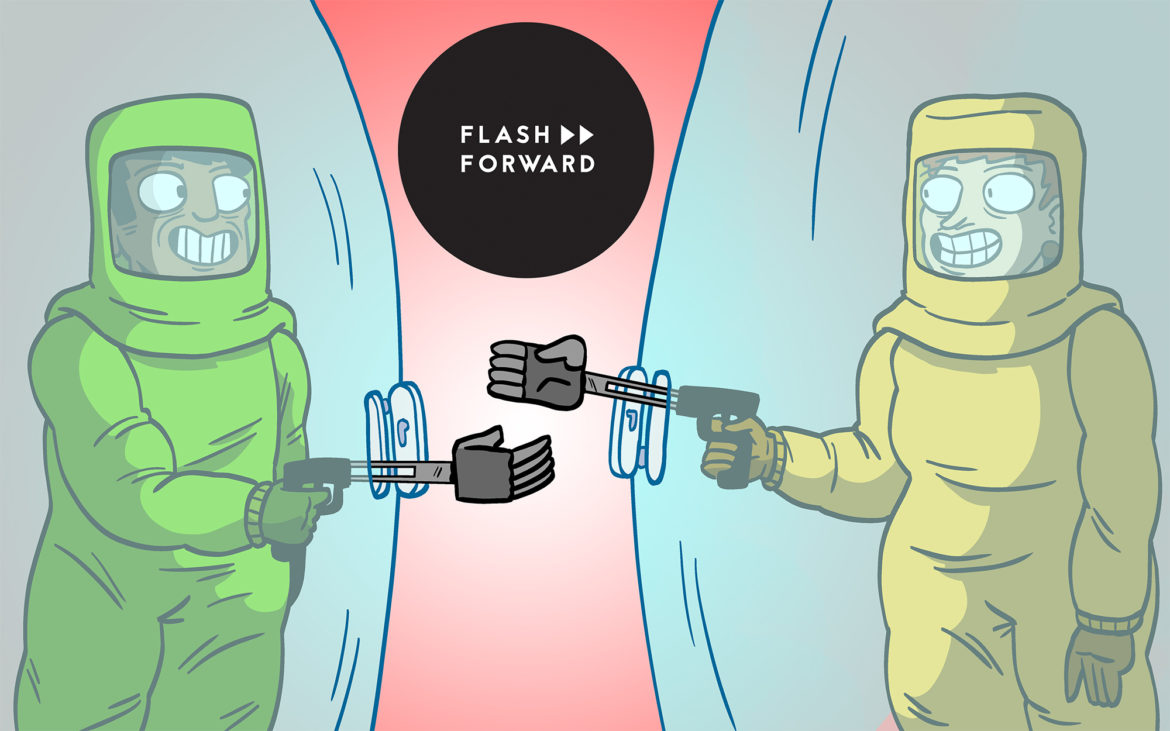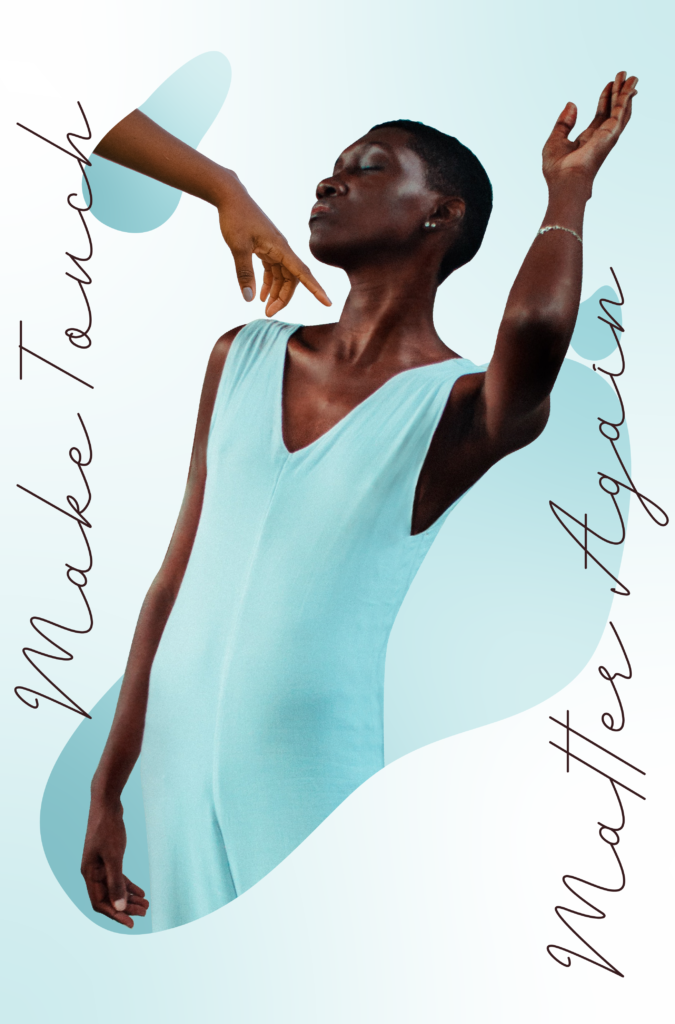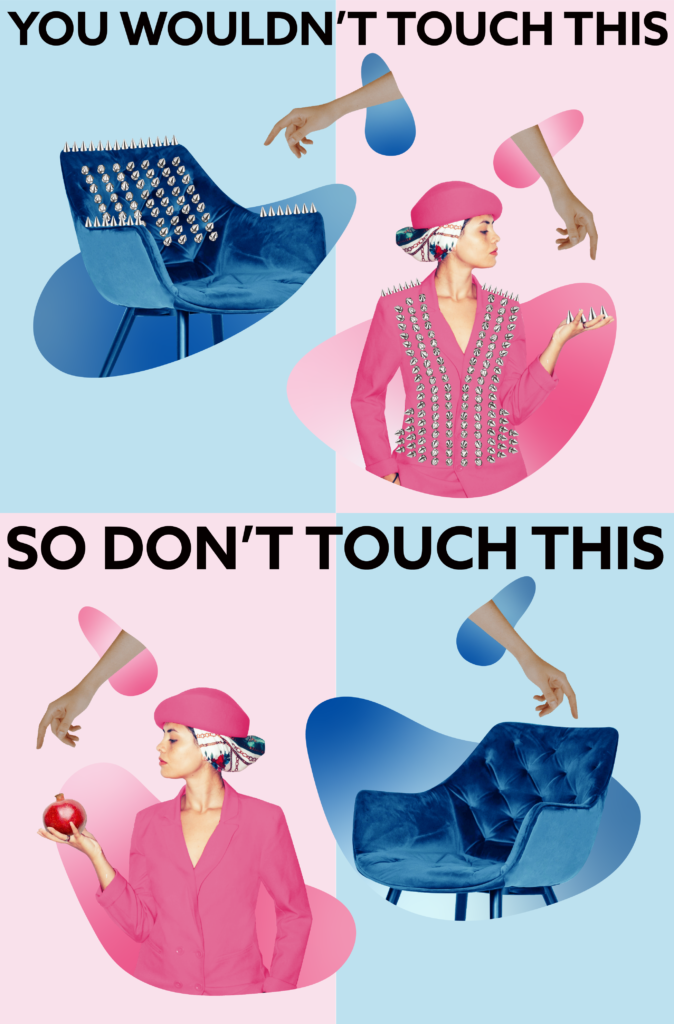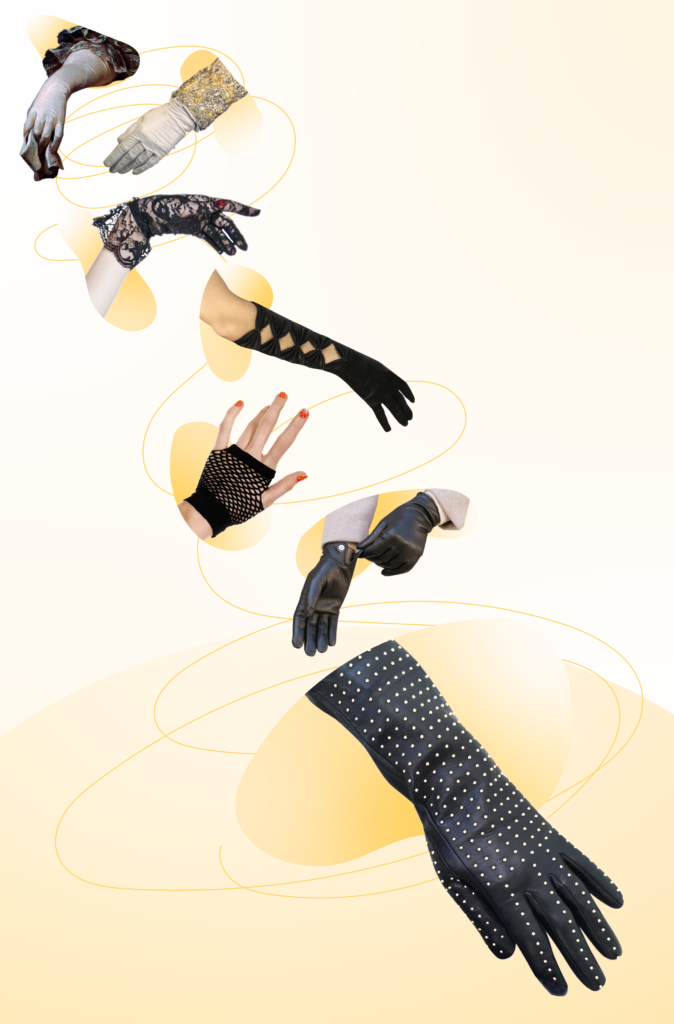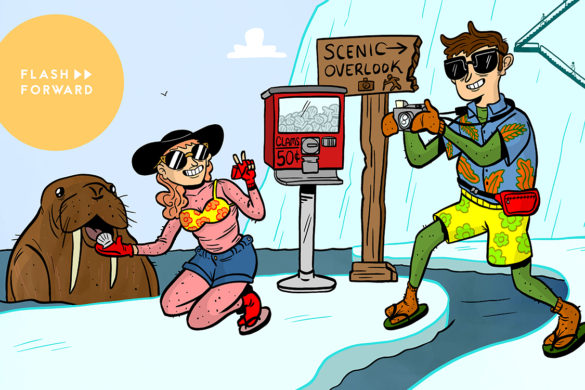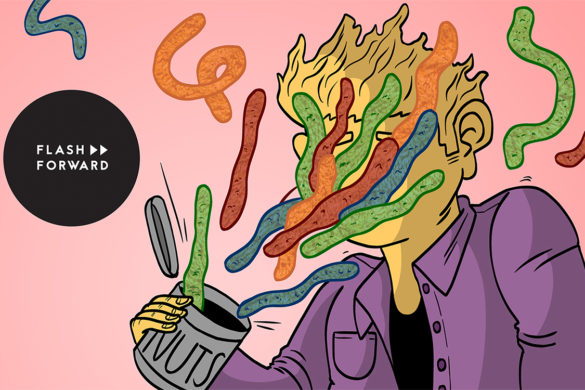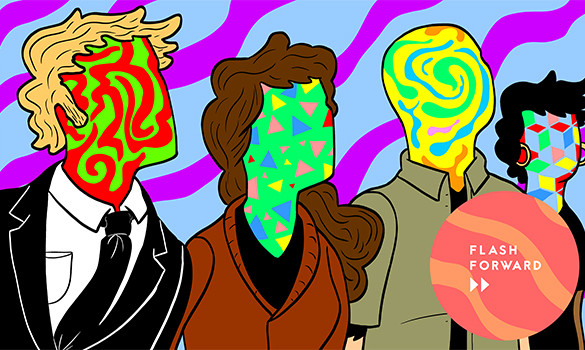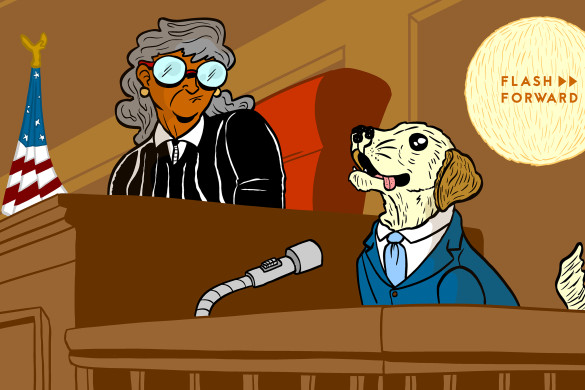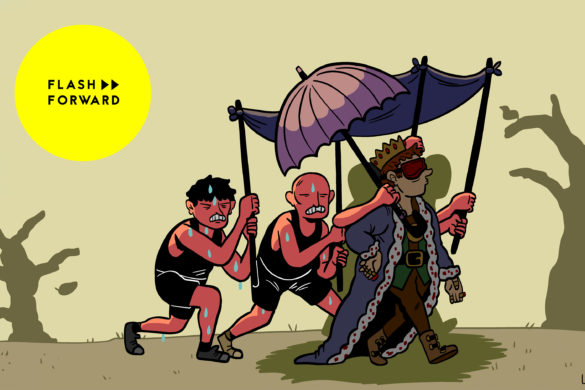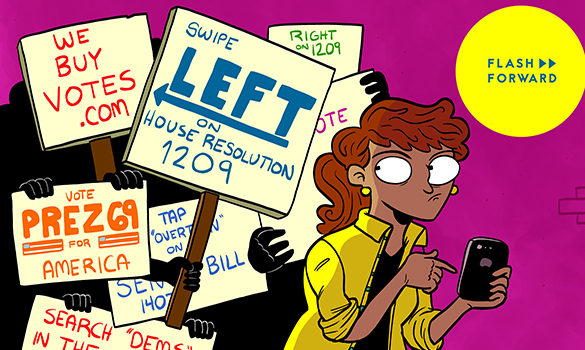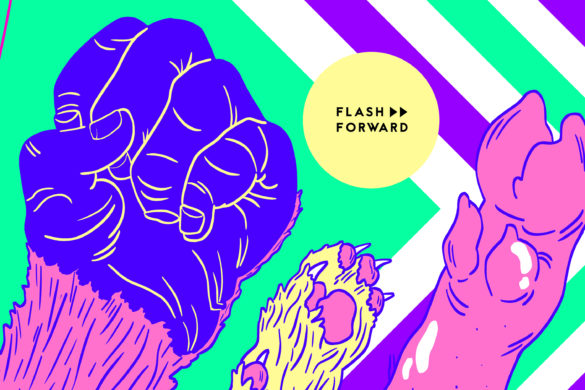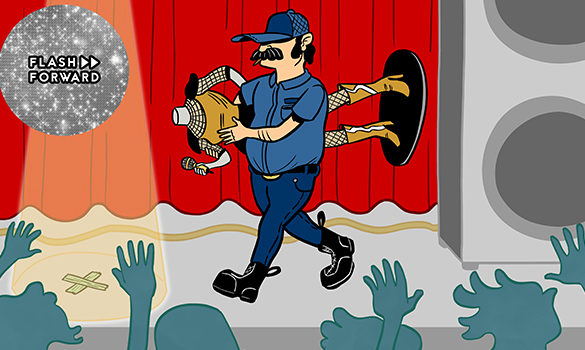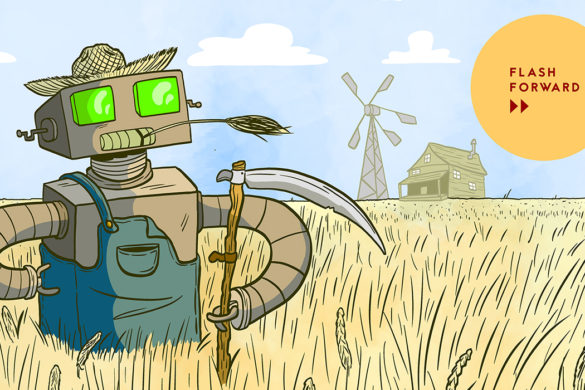Today we travel to a future where you can’t touch anything.
Guests:
- Dr. Angela Rasmussen, a virologist currently working at the Georgetown Center for Global Health, Science and Security but soon to be head of her own lab up at the University of Saskatchewan.
- Dr. Catherine Kudlick, a historian and the Director or the Paul K. Longmore Institute on Disability at San Francisco State University.
- Dr. Tiffany Field, the director of the Touch Research Institute at the University of Miami School of Medicine.
- Dr. David Parisi, a professor at the college of Charleston, and the author of a book called Archaeologies of Touch: Interfacing with Haptics from Electricity to Computing.
Voice Actors:
- Naomi Jackson — Shara Kirby
- Dr. Sandra Bowles — Richelle Claiborne
- Advertisement Voices — Rachel Lara, Jake & Rory Terracina, and Kathryn Dollens
Posters! By Sar Ruddenklau.
Episode Sponsors:
- Skillshare: Skillshare is an online learning community where millions come together to take the next step in their creative journey, with thousands of inspiring classes for creative and curious people, on topics including illustration, design, photography, video, freelancing, and more. Start with two free months of Premium Membership, and explore your creativity at Skillshare.com/flashforward.
- BetterHelp: Affordable, private online counseling. Anytime, anywhere. Flash Forward listeners: get 10% off your first month at betterhelp.com/flashforward
- Shaker & Spoon: A subscription cocktail service that helps you learn how to make hand-crafted cocktails right at home. Get $20 off your first box at shakerandspoon.com/ffwd.
- Tab for a Cause: A browser extension that lets you raise money for charity while doing your thing online. Whenever you open a new tab, you’ll see a beautiful photo and a small ad. Part of that ad money goes toward a charity of your choice! Join team Advice For And From The future by signing up at tabforacause.org/flashforward.
- Tavour: Tavour is THE app for fans of beer, craft brews, and trying new and exciting labels. You sign up in the app and can choose the beers you’re interested in (including two new ones DAILY) adding to your own personalized crate. Use code: flashforward for $10 off after your first order of $25 or more.
- Purple Carrot: Purple Carrot is THE plant-based subscription meal kit that makes it easy to cook irresistible meals to fuel your body. Each week, choose from an expansive and delicious menu of dinners, lunches, breakfasts, and snacks! Get $30 off your first box by going to www.purplecarrot.com and entering code FLASH at checkout today! Purple Carrot, the easiest way to eat more plants!
Flash Forward is hosted by Rose Eveleth and produced by Julia Llinas Goodman. The intro music is by Asura and the outtro music is by Hussalonia. The episode art is by Matt Lubchansky. The voices from the future this episode were provided by
If you want to suggest a future we should take on, send us a note on Twitter, Facebook or by email at info@flashforwardpod.com. We love hearing your ideas! And if you think you’ve spotted one of the little references I’ve hidden in the episode, email us there too. If you’re right, I’ll send you something cool.
And if you want to support the show, there are a few ways you can do that too! Head to www.flashforwardpod.com/support for more about how to give. But if that’s not in the cards for you, you can head to iTunes and leave us a nice review or just tell your friends about us. Those things really do help.
That’s all for this future, come back next time and we’ll travel to a new one.
FULL TRANSCRIPT BELOW
▹▹ ▹▹ ▹▹ ▹▹ ▹▹ ▹▹ ▹▹ ▹▹ ▹▹ ▹▹ ▹▹ ▹▹ ▹▹ ▹▹ ▹▹ ▹▹ ▹▹ ▹▹ ▹▹ ▹▹ ▹▹ ▹▹ ▹▹
[Flash Forward intro music – “Whispering Through” by Asura, an electronic, rhythm-heavy piece]
ROSE EVELETH:
Hello and welcome to Flash Forward! I’m Rose and I am your host. Flash Forward is a show about the future. Every episode we take on a specific possible… or sometimes not-so-possible future scenario. We always start with a little field trip into the future to check out what’s going on, and then we teleport back to today to talk to experts about how that world that we just heard might actually go down. Got it? Great!
This episode, we are starting in the year 2064.
Oh, and there is one curse word in this episode, just FYI.
FICTION SKETCH BEGINS
[auditorium setting, crowd quiets as speaker approaches]
MODERATOR:
Hello and welcome to the 34th Annual Cedar Ideas Festival. My name is Naomi Jackson and I’m so excited to have you all here. As you might know, my day job is editing The Pacific magazine, which brings you complex perspectives on big ideas. For the magazine, we spend a lot of time thinking about big “Why” questions. Why did this happen? Why is our country set up the way it is? Why are some people happy or unhappy? Why do we make the choices we make, as both individuals and as a collective? And when it comes to not just understanding behavior, but shaping it, there is no one more experienced, more impactful, more visionary, than our keynote speaker.
Dr. Sandra Bowles has spent over 50 years developing and shaping iconic campaigns that have really shifted the course of history. From Gucci, to SpaceX, to the CDC. For decades, she was anonymous; known in the industry simply as SB, a mysterious genius who would swoop in to solve problems and deliver perfect, groundbreaking campaigns. Today she’s a professor emeritus at Howard University and consults for national governments, high-impact brands, and international superstars. And tonight, she’s here to give us a glimpse into how her mind works and what it takes to shift the narrative.
Please, join me in welcoming Dr. Bowles.
[applause]
DR. BOWLES:
Thank you. Thank you for that lovely introduction, Naomi. It’s an honor to be here. I admit that I’m still getting used to being a named figure. It’s lovely of course, to be recognized, but there is something quite nice about anonymity too. Along with it being a nice marketing strategy of course.
[crowd laughs lightly]
When Naomi asked me to come and talk about my work, I wasn’t quite sure what to say. But her framing of “why do people make choices” resonated with me. Because really when you think about advertising, it’s all about convincing people to make the choices you want them to make. And I use that word, convincing. Not tricking. Not forcing. Not bribing. Convincing. If you want your campaign to really work in the long run, you have to convince someone to do something. Whether that’s buying a coat or washing their hands.
Convincing someone requires knowing why they don’t want to do whatever it is you want them to do. What is the dialogue in their head saying “Eh… you don’t need this.”? What does the little angel on their shoulder say to them to rebut you? You have to know that; you have to figure it out. And if you get that wrong, you’re never going to succeed.
Let me give you an example. Early in my career – after I’d made a name for myself here and there as someone who had big ideas and who could pull them off – I was handed a really big challenge. It was 2035 and things were dark. Everybody was getting sick. I’m sure you remember. People were sick, and they were tired. Tired of being sick. Tired of listening to public health instructions go back and forth and back and forth. We had just come out of a back-to-back pandemic. We thought we were in the clear and that we could finally go back to normal. Hug our friends, have parties, sing karaoke. We all wanted the scientists to just take a break, take a day off of something.
Meanwhile, their messaging was all muddled up. It was bad, but not a pandemic. Or at least not the same kind, right? People were dying, and catching whatever this was, and giving it to each other, but not like the last time. It was confusing. I think of myself as a smart person and I was confused. And also tired of constantly being afraid of stuff that I didn’t understand. That scientists didn’t understand. And so I ignored them, a lot of us did. Here’s what the CDC PSAs looked like at the time.
[light springy music, friendly voice:]
Remember to keep you and your family safe by reducing contact with surfaces that someone else might have come into contact with in the last 17 minutes. We can all do our part by following public health recommendations.
Do you remember these? I remember ignoring them. And then I got a call from Atlanta, from the head of the CDC, who basically said, “We need your help to save millions of people’s lives.” And I mean, how do you say no to an ask like that? So I flew down to Atlanta and I figured out what we needed to convince people to do, and it was actually all about convincing people to not do something. No touching.
And this was the confusing part, right? For so long it was, “Don’t be around people. Don’t breathe in their germs.” But now it was slightly different: You can be near them, but don’t touch. Touching is the problem. Hang out all you like, scream all you like, but don’t hug. No skin contact. How do you convince people to stop touching each other, stop touching the world around them?
Well first, you have to get them to even think about touch in the first place, right? I mean, before all of this – remember, this was 2035 – people would touch pretty much anything. I know it sounds bizarre now, but you remember that don’t you? Or maybe you’re all too young. But we’d touch everything! We’d shake strangers’ hands. We picked up fruit in the store, just to touch it and then put it down again. Nobody cleaned the handrails. How do you convince people to stop doing something they don’t even realize they’re doing?
I decided to start with the touching that we think about – the intimate, sexy stuff. That’s where we started. So we released this ad campaign.
[sexy music, whispery voice:]
Touch.
Our most sensitive, intimate sense.
[water splashing]
The key to our brains, and our hearts.
Touch.
The key to our future.
[sensual breathing]
Protect it.
Make touch matter again.
“Make touch matter again.” That was our whole goal. Making touch this really specific thing that we think about and really consider before we do it.
Then, once people were thinking about touch, we made, probably, the more famous posters where every surface is covered in spikes. Maybe you remember them. Convincing someone that something can hurt you is hard if you can’t see it.
And then our final campaign was aspirational, because if you’re going to convince people to give something up you have to give them something in return. And that something can’t just be… safety. I mean, who cares, right? You have to give them something to aspire to, to want.
And so we worked with Prada to create this incredible line of gloves. And really, gloves are so much easier to make cool than masks, so I had it easy. But we wanted them to have that combination of old-school vintage fashion, and modern, more streetwear kind of flare to them. So here’s an early sketch of the gloves, a prototype. And then eventually we got to these.
And this campaign that you might remember.
[driving music, multiple wispy voices]
Touch.
Touch.
Touch.
Touch with abandon.
Touch with confidence.
Touch with gloves.
So now, I’m curious, how many of you in the audience are wearing gloves? Yeah… Wow, okay. Yeah, most of you.
And this was really the first campaign I worked on that had a, kind of, global implication and that you could see the impacts of in a real way. People did stop touching stuff. I mean, you probably don’t touch stuff now because of this campaign, if I may brag a bit. Rates of touching went down 85%, and with it, incidences of sickness and death went down. I mean, that’s a dream come true for any designer, right? To literally save lives with your silly little ad campaigns?
So that was my first big success. And I learned a lot from it that I used for future campaigns… if you’ll indulge me in those examples too…
[fades out]
FICTION SKETCH END
ROSE:
So today we are talking about touch and specifically what would happen if we had to give it up. Over the last year or so, a lot of people around the world have experienced a sudden shrinking of their world. And I have spent a lot of time in the last few weeks thinking about how in the early days of the pandemic a lot of us were focused on, sort of, the wrong things, right? Specifically, we spent a lot of time talking about cleaning surfaces. Cleaning your groceries. Quarantining your mail. Sanitizing every surface constantly.
[clips of news report]
Reporter:
People on social media are taking pictures of themselves sanitizing their groceries…
Community Member:
Yeah, with the reports of where it can live on and how long it can live on these different surfaces, like, no one knows what they can trust.
Expert:
Certainly, wiping down those surfaces of those milk containers, or cans, or anything, is not a bad idea.
It turns out, that’s not generally necessary.
DR. ANGELA RASMUSSEN:
This is a respiratory virus. In order for a respiratory virus to infect a host, it has to get into the respiratory tract. The easiest way for that to happen is by breathing it in, inhaling it in, or potentially touching it or getting splashing into your respiratory tract.
ROSE:
This is Dr. Angela Rasmussen, a virologist currently working at the Georgetown Center for Global Health Science and Security but soon to be the head of her own lab up at the University of Saskatchewan. Now, you can get Covid-19 from touching stuff. The virus does live on surfaces.
ANGELA:
There was a guy who got into an elevator, blew his nose into his hand, and then touched a button on the elevator, getting snot or, you know… snot, all over. Actually, snot was the term they used in the paper, getting snot all over that elevator button. A little while later, somebody else got in the same elevator. They couldn’t find another way that he had been exposed. And of course, he got SARS-Coronavirus-2. And so it was assumed that by touching that snot-covered, virus-covered elevator button, he got virus on his hands and then he probably touched his nose or his mouth and became infected.
ROSE:
Yes, you did indeed hear that correctly. This person blew their nose into their bare hand, and then touched an elevator button with that hand.
ANGELA:
The thing I’ve learned is that people are just gross, and it’s not just little kids. People can be really gross.
ROSE:
But looking back at news stories and tweets from about a year ago I started thinking about what it would be like if there was some kind of really deadly disease that was only transmitted by touch. Something that you couldn’t get simply by being near someone, but you could get if you touched them. What if we could never touch each other, or our world, the same way again? How could we convince people to stop touching stuff? You heard about that in the intro.
Oh, and those ad campaigns you heard about in the intro, I actually commissioned an amazing designer to make those posters real, and you can find them in the blog post for this episode at FlashForwardPod.com.
The first thing we have to figure out for this future is what exactly this disease is. And to figure this out, we have to understand how diseases actually enter your body in the first place. Most infectious diseases, most bacteria and viruses, they can’t just absorb into your body through your skin.
ANGELA:
The surface of your skin is essentially a mat of dead skin cells that are full of this protein, keratin. And that actually forms a pretty solid barrier. The other reason is that they are dead. So viruses are obligate parasites and they have to have a living host cell to replicate in. They can’t infect, really, a dead cell. They could maybe infect and gain entry to a cell that had just recently died, but they wouldn’t be able to productively replicate in that and establish an infection.
ROSE:
They need an easier entry point; an unprotected route into your body.
ANGELA:
Your eyes, your nose, the inside of your mouth, vaginas, rectums. All those sensitive orifices of your body that don’t have that tough layer of dead keratinized skin cells on the surface. That’s why those are good routes for a pathogen to gain entry.
ROSE (on call):
Is there a virus, bacteria, something that is truly only transmitted by touch? Obviously there are, like, fungal infections that you can get on your skin that seem to be from that, but like, when you think about just contact transmission, what are the first things that come to mind?
ANGELA:
So, this is a complicated question. It’s deceivingly complicated because I can’t think of any that are transmitted just by touch, meaning that your skin cells are going to get infected with the virus that comes into contact with them. You can certainly get some viruses if you have, say, a cut on your hand and you touch a source of virus. There are many viruses, blood-borne viruses like hepatitis C virus, for example, that are transmitted mostly these days by injection, injecting drug use here in the US. Or, you know, HIV is another one that can be transmitted parenterally, basically through exposure to blood.
But you know, somebody with an intact skin is not going to necessarily be susceptible to that just by touch. There are some viruses… And this is where this gets complicated. Say, norovirus. Everybody knows about norovirus. It’s incredibly infectious. And you can get that from, basically, being exposed, by breathing, by exposing your oral mucosa to those virus particles. That’s why it spreads like wildfire through cruise ships, and shared bathrooms, and things like that. You can also get it by touch, but it’s not getting in through your skin.
ROSE (mono):
Some viruses live on surfaces for way longer than others.
ANGELA:
So, things like herpes and smallpox virus, those were transmitted by fomites, or thought to be transmitted by fomites, because their genome is very stable.
ROSE:
Herpes and smallpox have DNA genomes, whereas something like this current coronavirus has an RNA genome.
ANGELA:
The RNA genome itself can be very easily destabilized. It can be degraded very quickly by environmental conditions like temperature changes. It can be degraded by RNase or ribonuclease enzymes that degrade RNA that exist ubiquitously in the environment.
ROSE:
Thankfully, we know how to treat most herpes infections and we have a vaccine for smallpox.
ANGELA:
I would say that we should be glad that our forebears were all vaccinated against smallpox because that’s certainly something that was transmitted by fomites. But of course, it’s hard to look back at some of the things that were transmitted by touching a rail, like smallpox – which is an incredibly lethal and horrible disease and you don’t want to get smallpox – because our hygiene standards have changed drastically. Our cleanliness standards have changed drastically.
ROSE:
So, to figure out what this potential nasty thing could be, I did a deep dive and I came up with this whole long list to ask Angela about. Fungal infections: No, those mostly get into your body from the air. Prions, like mad cow disease, which are terrifying: But no, not transmitted by touch.
ANGELA:
There’s a reason why, like, the entire world that does eat beef is not dying of mad cow disease. I mean, prions, it’s real bad if you get a prion disease, no question, but you’re not likely to get one.
ROSE:
Helminths, or botflies, are also very gross but probably not going to become a pandemic.
In doing this research I also learned about something called cutaneous anthrax, a bacterial infection that you see in people who handle animals and leather workers.
ANGELA:
So, cutaneous anthrax actually doesn’t just cause anthrax when it gets on your skin. It’s getting into, like, some kind of cut or rash. Like, you have to have some kind of breach of skin barrier integrity in order to get cutaneous anthrax. When you get it, it sucks. It looks horrible. But you aren’t going to get cutaneous anthrax just from handling anthrax spores if you don’t have any cuts or rashes on your skin.
ROSE:
Basically, it’s really hard to think of something that could become a big, global pandemic but that was only transmitted by touch. But that doesn’t mean you shouldn’t wash your hands.
ANGELA:
If it was something that you could get just by absorbing it through the skin, then I don’t know, honestly. We’d be fucked. (laughs) But I think that that’s very unlikely.
ROSE:
Now, that doesn’t mean you should stop washing your hands. The thing about infectious diseases is that they’re not playing interdimensional chess here.
ANGELA:
Viruses don’t think about anything. They don’t have brains. They’re not sentient. They are just little machines, basically, that are trying to make new viruses because that’s what they’re programmed to do. And they don’t really care whether they’re flying through the air, whether they’re floating in the air, or whether they’re on a surface. If they find a cell that they can infect, they’re going to infect it just because they’ve been programmed to do so.
ROSE:
Most diseases can be transmitted in more than one way. Take the current coronavirus pandemic. Yes, most of the cases are airborne transmission, but again, you can definitely still get it from touching a surface and then touching your face. You should wear a mask and wash your hands.
But this is Flash Forward and we don’t necessarily have to stick to the rules of reality. So let’s say that we do live in this future with this, sort of, mythical disease that spreads only by touch. So you can be around people all you like; you can stand next to them, be in the same room as them, but you just can’t touch them, or really touch anything.
Angela says that, overall, the public health recommendations would probably be kind of similar to what we’ve seen in the last year.
ANGELA:
You know, people would wear masks that would keep people’s hands away from their faces. People would socially distance. I guess they wouldn’t have to worry about ventilation if it was just via close contact transmission.
ROSE:
Along with masks, we might also all wear gloves around all the time. A few years ago we talked on this very show about the rise of face masks as a fashion item in the future – and frankly, I maybe should have invested in face masks then, because we were way ahead of the curve. And in this future, the preventative accessory would probably be gloves. Fancy gloves, streetwear gloves, branded gloves, specialized gloves that actually fit you if you have small hands like me. Would you buy Flash Forward gloves? Should I not miss my chance again this time? Probably I will miss it, and we will see.
ANGELA:
Personally, I would love that. Like, I love all those old movies where people are wearing, like, elbow-length gloves. I would absolutely adore gloves to make a comeback.
ROSE:
But Angela also says that we should remember the role of things like masks and gloves in public health. They are one piece of the puzzle, not magical barriers.
ANGELA:
I think that there’s still a lot of opportunity for those types of PPE to become useless if they’re not made out of the right materials, if they’re not fitted properly, if they’re not worn in the right circumstances, if they’re not changed enough. So I’d be perfectly content with people just having more consciousness about hand hygiene, about keeping commonly touched surfaces clean and disinfected.
ROSE:
More important than cool gloves, if we really want to prevent the next pandemic, whether it’s about touching things or not, we need to also have things like paid sick leave so people who aren’t feeling good can actually stay home.
Public health has to weigh a lot of different considerations, and not all of them are biological. Many of them are cultural, and how people react and interact with each other.
DR. CATHERINE KUDLICK:
Maybe we all just evolve into, like, avatars and all the people’s bodies go somewhere else.
But first, a quick break.
ADVERTISEMENT: BETTERHELP
This podcast is sponsored by BetterHelp.
Is there something interfering with your happiness, or preventing you from achieving your goals? Are you wondering how exactly you’re supposed to go back to normal, now that you might have access to a vaccine? Or maybe there’s just some big life thing that’s about to happen to you and you wish you could talk to someone about it. BetterHelp is here for all that and more.
BetterHelp will assess your needs and match you with your own licensed, professional therapist. And you can start communicating in under 48 hours. This isn’t a crisis line. It’s not self-help. It is professional counseling done securely online.
BetterHelp has a broad range of expertise available, including stuff that might be hard to find near you if you had to go to therapy in person. And the service is available to clients worldwide. You can log into your account anytime and send a message to your counselor, and you’ll get timely and thoughtful responses. Plus, you can schedule weekly video or phone sessions so you won’t ever have to sit in an uncomfortable waiting room as with traditional therapy. Plus, BetterHelp is committed to facilitating great therapeutic matches, so they make it easy and free to change counselors if you need to.
BetterHelp wants you to start living a happier life today. Visit BetterHelp.com/FlashForward and join the over one million people who have taken charge of their mental health with the help of an experienced professional. In fact, so many people have been using BetterHelp that they’ve actually recruited additional counselors in all 50 states. If you want to try it out, Flash Forward listeners get 10% off their first month at BetterHelp.com/FlashForward.
ADVERTISEMENT END
ADVERTISEMENT: SKILLSHARE
This episode is supported by Skillshare.
Skillshare is an online learning community that offers membership with meaning. With so much to explore, real projects to create, and the support of fellow creatives, Skillshare empowers you to accomplish real growth.
As many of you know, my hobby is making ceramic sculptures. They are not good and I have no interest in turning them into some side hustle or business, but I love making them and I’m getting better over time. You don’t have to pick up skills with some grand vision or business plan in mind. You can just do stuff because it seems cool.
And Skillshare is full of classes that can help you learn new things or brush up on skills you already had. You can learn how to create successful YouTube videos with Marques Brownlee, or maybe you’re more of a short form creator and you want to learn how to make amazing one-minute videos for Instagram. You can do that too with a class taught by Hallease Narvaez. Or maybe you got the Flash Forward book and you’re inspired to learn how to create comics! There are tons of classes for you on that on Skillshare.
No matter what you do, there’s nothing better than getting better. Accomplishing growth is incredibly satisfying. Even the smallest step can feel like a huge breakthrough. I recently figured out how to dip glaze my sculptures and it was a real gamechanger.
Do something you couldn’t do yesterday, with classes designed for real life. And you don’t have to break the bank either. Skillshare is also incredibly affordable, especially when compared to pricey in-person classes and workshops. An annual subscription is less than $10 a month.
Explore your creativity at Skillshare.com/FlashForward and get a free trial of premium membership. That’s Skillshare.com/FlashForward.
ADVERTISEMENT END
ROSE:
Okay, so we’re in this future where we can’t really touch anything without risking contracting some deadly disease. The first thing that would probably happen, once we figured out that touch was the transmission method, is fire.
CATHERINE:
I think people would go to the place of destroying the objects.
ROSE:
This is Dr. Catherine Kudlick, a historian and the Director of the Paul K. Longmore Institute on Disability at San Francisco State University.
CATHERINE:
So like during the plague years, they burned clothing, they burned mattresses, they fumigated… It might even lead to a new kind of airborne problem if everybody’s burning their mattresses and clothes that they’ve touched as a curative sort of thing. You got all the smoke and whatever. But I think that would be the initial reaction.
ROSE:
If you have ever had bedbugs, you might actually understand this impulse. If you have never had bedbugs, count your lucky stars, thank whatever god you believe in, and knock on all the wood because, trust me, it is horrible and you genuinely do want to burn down your entire apartment. Anyway, whatever we did not destroy in this future, we would try to clean.
CATHERINE:
Sanitizing wipes and, you know, sanitation locks and things like that.
ROSE:
Sounds familiar, doesn’t it?
CATHERINE:
You’d go through the ritual we went through in the first weeks of Covid, you know, leaving your groceries outside, and wiping them down, and all of those things. But I do think there would be a tendency to just really throw stuff out. It might even change our relationship to stuff, you know?
ROSE:
I also called Catherine because not only is she a historian of epidemics, she also has another expertise. Catherine also studies disability history and is legally blind.
CATHERINE:
And I was thinking about blind people, because if we’re out there touching everything to see it, you know, that’s not… and you don’t know how to keep six feet away or you can’t confirm all the time that you’re six feet away from another person. It seems to me that that’s a kind of risky situation in an epidemic.
ROSE:
And I called her because I was thinking about who would be the most impacted by a world in which you really shouldn’t touch anything. Blind folks use touch in all kinds of really interesting and unique ways, but maybe the most famous is using touch to read.
CATHERINE:
Historically, they learned through touch. That was the alternative, and there were lots of different systems that were out there. I mean, before Louis Braille came along and perfected this system of reading with the six raised dots.
ROSE:
If you’ve never watched someone read braille fluently, I really recommend it because it is actually incredibly impressive. But unfortunately, braille has kind of fallen out of favor. In fact, some estimates suggest that, today, less than 10% of blind people actually read braille.
CATHERINE:
And that’s because there’s been an assumption that technology fills the gap, but also there’s been cutbacks in education, and so the teachers that would have been teaching blind kids this, they’re a lot fewer and farther between. So they’re mainstreamed in schools and there’s no real critical mass of people all learning braille once you have people dispersed in all these different schools. And then there’s the shame factor because people view blindness as, like, this terrible thing. And if you have to resort to braille, it’s seen as this capitulation.
ROSE:
Today there are all kinds of technologies that people can use instead of braille, but they don’t actually fully replace the system.
CATHERINE:
Oh, no, it’s a terrible, terrible loss. Because if you think about it, learning to read with your fingers, if you can’t see, that’s the only way you’re going to learn how to spell and do punctuation. It’s the only way you’re going to learn basic grammar because if you’re not seeing it, you’re not going to hear it on a voice recording or anything. You won’t know what those words are.
It’s always interesting to me. I always know when I get an email from a blind person that’s never learned braille because the spelling is absolutely atrocious; it’s all phonetic. And it’s not their fault. It’s what they know, and what they learned, and what they were exposed to. But it’s heartbreaking because then it leads to lack of employment, lack of opportunities, all of these things, kind of, compound on each other.
I mean, I even think… Your epidemic story aside, I think it would be really, really fabulous if everybody learned braille. Wouldn’t that be the coolest thing? You’d have this other arrow in your quiver to be communicating, and understanding, and getting knowledge into your body, quite literally, in ways other than through your eyes or your ears.
ROSE:
I have actually tried to learn braille in the past, and it is very, very hard. But now I’m sort of inspired to try and pick it back up again because it really does feel like this sense that I haven’t developed very well, that’s sort of going unused. So if anybody wants to learn braille with me, I don’t know, head to the Flash Forward Facebook group and say hello. Maybe we can have a little braille learning club!
Of course, losing touch would not just impact folks with visual impairments.
CATHERINE:
I think there’s, kind of, a sense of touch that’s really, really profound and it goes into our hardwired selves to think of how we know things, and really it solidifies it, I think. And to probably anticipate one of your questions, I think if the sense of touch is jeopardized, it means that this certainty and this foundational grounding of the human body is taken away, and that’s really, really tough.
ROSE:
In fact, there is plenty of research that suggests that touch is really important for our human development and our health.
DR. TIFFANY FIELD:
Touch is definitely understudied as the first sense to develop. In the fetus, it’s basically… The skin is like an external nervous system. It’s hard to imagine what it would be like to be without touch.
ROSE:
This is Dr. Tiffany Field, the director of the Touch Research Institute at the University of Miami School of Medicine. And one of the questions I had for her was, honestly, kind of embarrassing. But it was: What counts as touch? Does it require skin-on-skin contact? Or just a certain amount of pressure? Or what?
Apparently, there is no one official answer, but most of Tiffany’s work defines touch by pressure and movement. So if you take your hand and you move it across your forearm such that the skin moves, that is activating enough of the receptors on your skin to make a difference.
TIFFANY:
That occurs when you’re being hugged. That occurs when you’re getting a good handshake. That occurs when you’re doing all kinds of different exercise. You’re moving the skin. And what we found, basically, is that moderate pressure touch achieves all of the physical and psychological benefits that we’ve reported.
ROSE:
These benefits include everything from keeping your immune system running better, to pain reduction, to better sleep.
Right now, about 68% of Americans say they feel touch deprived. We are not hugging our friends and family, bumping up against other people at a bar or a concert, or crammed into rides at amusement parks. And that’s with a virus that is mostly airborne, mostly not transmitted through touch. In our theoretical future world of this episode, it would be even more severe.
TIFFANY:
And it’s sort of ironic that during a period when we can’t touch each other, when touch is so good for the immune system and especially for warding off viruses, here we are; we can’t be touching.
ROSE:
And this would be one of the biggest challenges in this future for public health recommendations. Any time you’re trying to figure out how to keep people safe during a pandemic, you have to think about not just the risk of the disease, but the risk of the recommendations too.
ANGELA:
What happens when people can’t, you know, hug their loved ones.
ROSE:
That’s Dr. Angela Rasmussen again.
ANGELA:
Some of these interventions, like staying home and not seeing family members for months at a time, are very, very difficult. Keeping kids out of school long term is very, very difficult. And there are other, you know, harms that can occur from this. And so it’s always going to be a conversation of risk-benefit analysis and trying to balance the benefits and harms of, essentially, sequestering people from one another.
And I think that for something that was transmitted solely by direct physical contact with another person, you’d really be having an even larger discussion about the risks and benefits of interventions that would deprive people of physical human contact for a long period of time, at least until we could develop a vaccine.
ROSE:
If we actually had to give up touch for a while, we might try and find other ways to get this sensation safely.
CATHERINE:
I mean the other thing to think about is the role of pets and, like, whether pets would take on a new meaning, like, you know, we’re going to pet our cats, or we’re going to breed for certain kinds of furs or kinds of coats that allows… do they transmit this pathogen or does that become our stand-in. Or even artificial something-or-others, you know, growing some weird plant that would, like, be the thing that everybody would want to touch because they couldn’t touch anything else.
I mean, you think about something like rosary beads or something like that, this religious practice is along… They’re part of realizing that people need to be connected in some way, in a tactile way, whether we touch a plant in a ritualistic way or some other way. We’ve got these items in our lives that have significance. And who knows? Maybe there’d be a new… You know, for everything, there’s a market. No matter what, you breathe and there’s a market now. But you know, to think about ways that people can actually connect with these objects that are living, or nonliving, inanimate.
ROSE:
Catherine is right of course, there is a market for everything. And in fact, there has been a market for touch-based objects for a long time. And when we come back, we are going to hear about some of the ways technology could replace touch, and whether it will ever be as good as the real thing.
But first a quick break.
ADVERTISEMENT: KNOWABLE
What do NBA All-Star Chris Paul, NASA commander Scott Kelly, and super smart podcaster Kristen Meinzer have in common? They all have incredible experiences, and they have taken those experiences and crafted audio courses to teach you what they have learned. Those audio courses are on Knowable, which is a new app where the world’s top experts teach new skills in bite-sized audio courses.
It’s sort of like someone took a podcast, added audiobook, and put them in, like, a pressure cooker, and then stood back and released that pressure with a totally normal and not-terrified facial expression, and what they got were little snippets of pure, distilled learning.
NASA commander Scott Kelly teaches lessons learned from a career in space. NBA All-Star Chris Paul discusses the performance benefits of his plant-based lifestyle. And podcaster Kristen Meinzer tells you everything she has learned about how to be happier from years of research.
Knowable is accessible on your phone and on the web, and each audio course is broken out into individual lessons, usually about 15 minutes long. You can explore at your own pace, and each class is supported by downloadable materials, lessons, recipes, and more. I know that you like learning, okay? You don’t have to lie to me. We are friends, sort of. And this is a place where learning is cool and good, and you can do it on Knowable.
So are you ready to learn something new today? You can download the Knowable app or visit Knowable.fyi and use the code FLASHFORWARD for an additional 20% off.
ADVERTISEMENT END
ADVERTISEMENT: TAB FOR A CAUSE
All right, so let’s imagine for a moment that you are an astronaut and you want to get on the internet, obviously, so you can watch TikToks or whatever it is. And you can do that, it just takes a while. Astronauts on the ISS have to use a remote desktop tool on computers on the ground that have access to the internet. So every click has to go from the ISS to a geosynchronous satellite, back down to the ground. Then the actual click on the machine, they have to wait for the web, and then back up to the geosynchronous satellite, and then back over to the ISS. What that means is that even just moving a mouse around is slow because there are all these steps.
That fun fact comes from Patron William Andrews. But thankfully, you probably do not have to wait that long to browse the internet. It probably takes you, like, a second or less to open up a new tab and search for something. And if you use Tab for a Cause every time you open up a new tab, you can raise money for charity. With the Tab for a Cause extension, whenever you open up a new tab you will see a beautiful photo and a very small ad. Part of that ad money goes towards a charity of your choice. And you can join team Flash Forward by signing up at TabforaCause.org/FlashForward.
ADVERTISEMENT END
ROSE:
Okay, so before starting to work on this episode, I will admit that I did not spend a lot of time thinking about touch. I did see headlines about how people during Covid are touch deprived, and my friends have mentioned how much they miss hugging. But personally, I actually hate being touched by people that I don’t know really, really well. I hate hugs. Frankly, if we could just elbow bump forever, I would be totally happy with that.
But the reality is that touch is really important, even for me, a cold-hearted hug hater. And if we had to go cold turkey on it, it would probably be pretty bad. And in the place of real touch, we would probably see a lot of money pumped into touch simulators. Touch replicators. Stuff that can scratch that itch, both literally and figuratively.
And in fact, this idea of quantifying and replicating touch, it has a really long history.
DR. DAVID PARISI:
One of the things that was really revealing for me about this project was learning how far back this history goes. There’s this wave of experiments growing in complexity from the mid-1800s on.
ROSE:
This is Dr. David Parisi, a professor at the College of Charleston and the author of a book called Archaeologies of Touch: Interfacing with Haptics from Electricity to Computing.
In the 19th century, researchers realized that amidst all of the other research going on around the human body and how it interfaces with the world, they were leaving something out.
DAVID:
We have a lot of data. We have a lot of studies. We have a lot of philosophical thinking about sound, about vision. And we have this gap in knowledge around touch.
ROSE:
There are a lot of reasons why touch was, and is still to this day, kind of ignored.
DAVID:
I think part of the challenge concerns, sort of, a Christian theological distaste for the body, like a desire to transcend the notion that seeing is really the pathway to knowledge, that seeing is the pathway to the divine. So, I think that that plays into a lot of these sorts of cultural prohibitions around touching.
ROSE:
There’s actually an amazing experiment called the electrified Venus that we don’t have time to talk about right now, but I am going to talk about it on the bonus podcast this week. It involves kissing, and wax, and a man cranking a big electrical wheel, and it is… bizarre and amazing.
DAVID:
There’s that dangerous line between touch and desire, right? Between touch and sexuality, and that dangerous line between touch and pain, too.
ROSE:
And maybe that is one of the reasons why these 19th-century researchers decided to come up with a new word to describe what they were studying. Something other than “touch.”
DAVID:
So they come up with this new term, haptics. They use it to mean the science of touch.
ROSE:
Ah yes, haptics. That does sound far less intimate. And in their study of haptics, researchers really wanted to understand just how sensitive our sense of touch could be. If you think about, say, sight, we talk about the various colors that humans can see, which wavelength, our depth of field, how fast we can process images. And these scientists had the same questions about touch.
DAVID:
My favorite example that I talk about in the book is this apparatus for studying simultaneous touches.
ROSE:
The Apparatus for Simultaneous Touches looks a little bit like the machine from the Princess Bride.
[clip from Princess Bride, Count Rugen: “As you know, the concept of the suction pump is centuries old. Really that’s all this is except that instead of sucking water, I’m sucking life.”]
DAVID:
What they were trying to figure out in the 1890s was how many different places on the body you could discriminate tactile contact between. So, can you tell if you’re being touched five different places at once? Can you tell if you’re being touched six different places at once? Where is this, sort of, threshold for your tactile attentiveness? That’s, I think, a fascinating question to think about.
And the way they spoke to this question, the way they resolved it, was to build this frame that you would step into, with all these little pockets of air around the frame that they could inflate using, like a bellows, like what you would use to fan a fire. And they could inflate these bellows, and then they would ask the person in the frame, “Okay, how many different points do you feel?”
ROSE:
And this research is actually really important for our future scenario, because if we are going to try and replicate touch, if we are going to try and invent some kind of glove or even a bodysuit that makes it feel like, say, rain is falling on you, or someone is hugging you, or a cat is climbing into your lap, we need to understand how the human body and brain perceive touch. How much input of what kind can we actually parse?
Many years after this Apparatus for Simultaneous Touches, researchers tackled another angle of this question. This time, it was for the purposes of war.
DAVID:
This was a device that was intended to be a replacement for Morse code or be a better Morse code. And what it consisted of was five vibrators, five motors positioned around the skin, different spots on the skin around the torso. And each motor was capable of three steps of duration; short, medium, long; and three steps of intensity; low, medium, and high. So, nine signals per motor. And then with those five different motors, you’ve got a 45-character language that they can assign, you know, letters and numbers to.
ROSE:
And the inventor of this system, Frank Geldard at the University of Virginia, had to figure out just how quickly radio receivers could “read” these touch messages.
DAVID:
And it used a lot of the same data that they had generated, a lot of those same experimental methods, from the 1800s. So that question of, you know, “How many motors can we use?” directly relates back to that question of “How many different spots on the body can you perceive touch?”
ROSE:
Geldard imagined that maybe one day, all radio operators could be trained on Vibratese – yes, that is what it was called – and the military could transmit messages much faster than with Morse code.
Today, sadly, nobody is wearing a Vibratese vest, but there have been devices that translate the visual into tactile sensations. In the 1960s, a researcher developed something called a Tactile Television.
DAVID:
It’s an array of, again, like, little vibrating nubs that the initial version was done using a modified dentist chair. So, someone would walk around with a video camera and point the video camera at an object. This device, this Tactile Television system, would transcode that image into, basically, an array of vibrating dots projected against the subject’s back.
ROSE:
Now, this is not HDTV, here. We are talking about a pretty low-resolution image, just a bunch of different dots. But the idea is that over time your brain can learn to “see” these images more and more clearly.
DAVID:
This notion that you can translate… Your brain, if you sort of “brute force” these tactile images into the brain, the brain will learn to receive them, render them as visual images, over time with training. Very similar to the Vibratese system; eventually, with enough training, your brain will acclimate to it.
ROSE:
Around the same time as the tactile TV was being developed, another device hit the market that a lot of people actually miss.
CATHERINE:
The device that’s super cool, that a lot of blind people are really bummed has disappeared from the landscape, it’s a technology that not many people know about anymore. It’s called the Optacon. And it allows people to not just read words tactically, but to, you know, look at maps and see paintings. It’s a way to render visual imagery in a tactile way. And the people that used it, they just love this stuff. They’re just so excited. You know, it could communicate in a really great way, tactically.
ROSE:
Unfortunately, the Optacon was discontinued in 1996, but there are blind folks who still use them today. And in our future world, we might all be using them to get a feel for the world around us. In fact, in the early 2000s, there was kind of a hybrid version of the Optacon and the Tactile TV.
DAVID:
So what they did was, they shrank it, and they made it mountable in your mouth, and then it projects the image onto your tongue. So your tongue is obviously… has a very high density of touch receptors in it; much more accurate, much more high resolution.
ROSE:
These devices are still being developed today, mostly for blind people. But in our world of touch deprivation, could we also use them to simulate other inputs? To make it feel like we are getting a hug? Could your tongue implant talk to sensors in your ‘smart shirt’ and make you feel pressure here or there, even while maintaining a safe, non-touching distance?
And there is, in fact, a huge industry investing a lot of money right now into these questions.
DAVID:
Since this reemergence of VR, there has now been a new wave of investment into bodysuits, into more robust high-definition applications of haptics technologies. I’m thinking of the company HaptX and their Force Feedback, tactile feedback glove, which is an incredibly complex, incredibly nuanced piece of technology that, in combination with a telerobotics system, allows people to manipulate objects in real time across the world. And that, sort of, embodies this earlier dream that we were talking about before, that you’re going to be able to reach out and feel something across the world as if you were there.
ROSE:
If we can’t touch the world around us, or our friends, we might revert to the next best thing: a simulated version where we can.
DAVID:
I think one of the reasons that the promise is so endlessly appealing is because it sounds really fantastic, right? Like, it sounds really wonderful. And I think part of the challenge is, we constantly make this analogy to… and it’s an analogy I made a little while ago. We constantly make this analogy back to image and sound recording. So, we think about this as just, sort of, the next step of technologizing the senses, the next step of stimulating the senses, using technology and seeing the promise. We move very seamlessly from talking about technologizing vision, and technologizing hearing, to technologizing touch.
So, what can this do if it ever realizes that promise? It makes travel sort of unnecessary. If I can, you know, don a VR bodysuit and feel like the wind is blowing against my skin, and feel raindrops on my skin, or I can feel the caress of someone who’s not near me… If I can feel those sensations very accurately, all of a sudden the promise of the real world sort of goes away and gets supplanted.
ROSE:
In a world without touch, we would also have to reimagine entire industries. Massage parlors would have to turn to robots. Sex workers would have to reimagine their jobs as well, something many of them have already had to do during the pandemic. How do you play contact sports without getting infected? How do doctors do their jobs? How do dancers choreograph differently when you can’t make contact with one another?
We often take touch, the physical way in which we interact with the world, for granted. Without it, we’d be in our own little bubbles. Even if we could hang out with our friends, or go to a restaurant, or resume the “normal” activities of the world, everything would be radically different.
And Catherine thinks that maybe we are due for a resurgence of touch appreciation.
CATHERINE:
I mean, the thing that’s interesting about touch is it’s seen as this retro sense. It’s kind of all seen as analog somehow. And yet I think, honestly, if we look to the future, there’s going to be a sense of touch that’s going to, like, propel people into some other future that we might not know about yet, that we will revisit touch, and rethink it, and re-engage with it somehow, be more aware.
ROSE:
What happens if we really revalue touch? And will we, when this pandemic subsides? Or will we go back to, kind of, forgetting about it?
While working on this episode, I’ve become acutely aware of all of the stuff I touch. My dog, my plants, my own face… all the time. There’s this little sculpture that I made that sits on my desk, and it has little spikes on it, and sometimes I hold it and push the little spikey bits into my palm just to see how it feels. I never thought about touch that much, and while I don’t like hugs, it would be really, really terrible to lose it.
Thankfully, this future is super unlikely! So go forth and touch stuff, you monsters!
But also: please do wash your hands.
[Flash Forward closing music begins – a snapping, synthy piece]
Flash Forward is hosted by me, Rose Eveleth, and produced by Julia Llinas Goodman. The intro music is by Asura and the outro music is by Hussalonia. The episode art is by Matt Lubchansky. The voices from the future in this episode were played by Shara Kirby, Rachel Lara, Jake & Rory Terracina, Kathryn Dollens, and Richelle Claiborne. The posters from our future were designed by the amazing Sar Ruddenklau. You can find those on the website.
If you have an idea for an episode, you can send us a note about it on Twitter, on Facebook, or by email at Info@FlashForwardPod.com. Julia and I love hearing your ideas. And if you think that you’ve spotted one of the little references that I’ve hidden in this episode, you can email us there too. If you are right, I will send you something cool.
If you want to talk about this episode and all the stuff you want to touch, or you want to talk about some other episode, or just the future in general, you can join the Facebook group. Just search ‘Flash Forward Podcast’ on Facebook and ask to join. There is one question that you have to answer. It’s incredibly easy, but I just want to make sure that you are in the right place and actually listen to the show.
And if you want to support Flash Forward, that would be incredible. The show is largely supported by direct donations from listeners. If you want to do that, you can go to FlashForwardPod.com/Support for more about how to give. If that is not in the cards for you, you can head to Apple Podcasts and leave a nice review, or just tell a friend about the show. Any friend. Even an enemy. Tell an enemy about the show! It doesn’t really matter. Word of mouth is how most podcasts get found, so anybody you tell, I will be greatly thankful for.
That’s all for this future. Come back next time and we’ll travel to a new one.
[music fades out]

